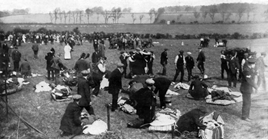Many of the surviving troops were sent straight back to Scotland by ambulance train, organised by the Caledonian Railway at Carlisle. The remainder were taken to Carlisle for treatment, but of those, one officer and 55 men were later declared unfit for service and sent back to Edinburgh.
Eventually, only seven officers and 57 men of 7RS were sent on towards Liverpool. Before embarkation, however, all the non-commissioned officers and men were declared unfit, and only the officers embarked for Gallipoli.
Back in Scotland, the funeral for the dead in Leith was attended by 3,150 soldiers. The men were buried in a mass grave at Rosebank Cemetery, Edinburgh, at a private service attended only by their comrades. It lasted three hours.
Today, many who work on the railway will have gone through a training session on the basic technicalities of block signalling. They will also have learned that not operating block equipment and observing procedures can result in terrible accidents.
The inquest found that this was what had happened at Quintinshill. The blame was laid at the feet of the two signalmen, Meakin and Tinsley, and the two men were found guilty of culpable manslaughter after they gave evidence of dereliction of duty.
Their shift pattern had been unofficially tweaked to avoid “getting up so early” for the 6am shift. Tinsley had started arriving at 0630, instead of 0600. For some time, Meakin had been writing down train times up to 0630 in pencil in the signal box’s register book. This meant that instead of keeping track of the trains passing his section and carrying out his duties as normal, Tinsley started his shift by frantically scribbling away at the register, copying down the times of trains that had already gone through.
The inquest found that Tinsley failed to observe that the slow train was still parked on the Up Main, and incorrectly gave the ‘Line Clear’ signal for the troop train to enter his section. The fact that he had “leaped off the engine” of that very train less than 30 minutes previously, followed by its fireman, makes his forgetting it seem unlikely. Nonetheless, it is possible, considering the fireman did not ensure Rule 55 had been followed, and left the box prior to the collision.
Rule 55 required train crews to ask the signalman why they were stopped, and what the situation was. Meakin also failed to place a collar on the lever of the signal that allowed the troop train into the section. Such a collar prevents signals being changed, as Tinsley did, when they ought not to be. Had Meakin applied this rule, the troop train would have been slowed (if not completely stopped) at the edge of his section. The ensuing panic meant the Down express had clear signals through Quintinshill, when it should have had danger signals presented as soon as the accident happened.
Sadly, very little improved as a result of the accident. Track circuitry was already being introduced in Britain, Rule 55 was already in place, and lever collars were standard practice in signal boxes. The two signalmen were re-employed on the railway before the end of the war.
Theories abound about German bribery, Tinsley suffering an epileptic fit on the morning he was on duty, and the crew of the slow train staying and distracting him. But despite a century of argument, it is unlikely that the whole truth behind Britain’s worst railway disaster will ever be learned.
- This feature was published in RAIL 776 on June 10 2015














Login to comment
Comments
No comments have been made yet.